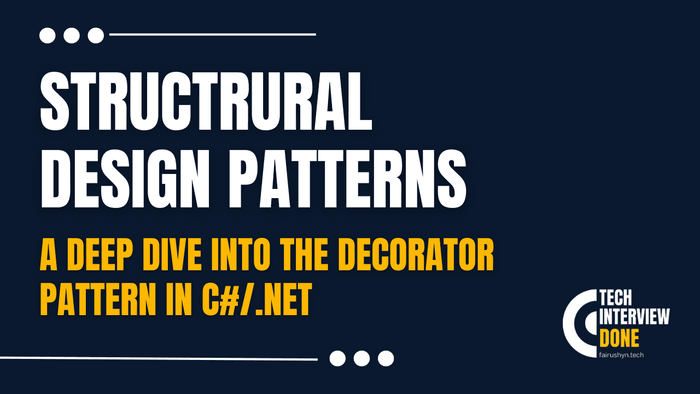A Deep Dive into the Decorator Pattern in C#/.NET
3 min read · — #design-patterns#structrural-patterns#decorator
Introduction
In the realm of software engineering, design patterns serve as blueprints for solving common design issues. Among these, structural design patterns focus on how classes and objects are composed to form larger structures. The Decorator pattern shines as a sterling example of such ingenuity, enabling dynamic extension of an object's functionalities without altering its structure. This intricate dance of flexibility and extensibility is particularly relevant in complex, evolving software systems where the cost of change is high and adaptability is paramount.
Embarking on this exploration, we'll dissect the Decorator pattern, understanding its mechanics, benefits, and how it elegantly solves the dilemma of inheritance versus composition. Through practical examples in C#/.NET, we'll see how this pattern not only enhances our code's maintainability but also upholds the Open/Closed Principle, ensuring our software systems are open for extension but closed for modification.
The Decorator Pattern: An Overview
At its core, the Decorator Pattern allows for the dynamic addition of behaviors to objects without modifying their existing classes. This is achieved by creating a set of decorator classes that wrap the original class, each adding its own behavior or functionality. The beauty of this pattern lies in its ability to layer additional functionalities on an object at runtime, offering a flexible alternative to subclassing for extending behavior.
Real-World Scenarios: Decorator Pattern in Action
Scenario 1: Customizing UI Components
Imagine you are developing a user interface library, and you need to offer customizable buttons. Each button could be
enhanced with different visual effects, such as borders, shadows, or animation. Applying the Decorator pattern, you can
create a base Button class and then separate decorators for each visual enhancement, such
as BorderDecorator, ShadowDecorator, and AnimationDecorator. This approach allows developers to dynamically
combine these decorations without spawning a bewildering hierarchy of subclasses.
public interface IButton
{
void Render();
}
public class BasicButton : IButton
{
public void Render()
{
Console.WriteLine("Rendering Button");
}
}
public class ButtonDecorator : IButton
{
protected IButton button;
public ButtonDecorator(IButton button)
{
this.button = button;
}
public virtual void Render()
{
button.Render();
}
}
public class BorderDecorator : ButtonDecorator
{
public BorderDecorator(IButton button) : base(button) {}
public override void Render()
{
base.Render();
Console.WriteLine("Adding Border");
}
}
// Usage
var myButton = new BorderDecorator(new BasicButton());
myButton.Render(); // Outputs: Rendering Button, Adding BorderScenario 2: Enhancing Data Streams
Consider a data processing application where data streams might need to be compressed, encrypted, or logged. With the
Decorator pattern, you can create a DataStream interface and implement a basic stream class. Decorators
like CompressDecorator, EncryptDecorator, and LogDecorator can then enhance these streams dynamically, providing a
versatile mechanism for data manipulation.
public interface IDataStream
{
void Write(string data);
}
public class FileStream : IDataStream
{
public void Write(string data)
{
Console.WriteLine($"Writing {data} to file.");
}
}
public class CompressDecorator : IDataStream
{
private IDataStream stream;
public CompressDecorator(IDataStream stream)
{
this.stream = stream;
}
public void Write(string data)
{
// Compress data
var compressedData = $"Compressed {data}";
stream.Write(compressedData);
}
}
// Usage
var myStream = new CompressDecorator(new FileStream());
myStream.Write("example data"); // Outputs: Writing Compressed example data to file.Advantages of the Decorator Pattern
- Flexibility: Decorators provide a flexible alternative to subclassing for extending functionality.
- Dynamic Composition: Objects can be composed and recomposed at runtime with various decorators, enabling dynamic behavior changes.
- Maintains Open/Closed Principle: Systems remain open for extension but closed for modification, adhering to solid software design principles.
Conclusion
The Decorator pattern is a powerful tool in the arsenal of a software engineer, particularly for those crafting systems that demand high levels of flexibility and maintainability. By understanding and applying this pattern in C#/.NET projects, you can create software that is not only robust and scalable but also elegantly designed to adapt to changing requirements with minimal disruptions. Whether it's enhancing UI components or streamlining data processing functionalities, the Decorator pattern holds the key to crafting adaptable and future-proof software architectures.
